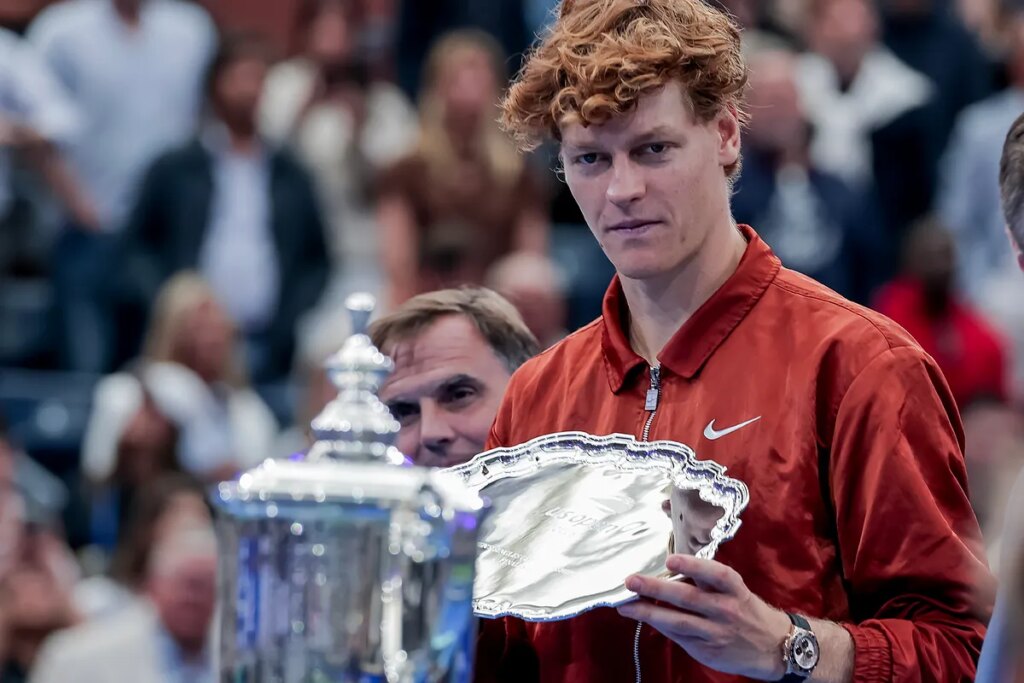Jannik Sinner entered the 2025 US Open final as the defending champion and world No. 1, but fell in four sets to Carlos Alcaraz. The result prompted scrutiny, not just of Alcaraz’s brilliance, but also of what went wrong for Sinner.
Now, Iga Swiatek’s coach, Wim Fissette, has offered an assessment of the match that highlights a factor rarely given enough credit: predictability. According to Fissette, a key issue was that Sinner’s style had become anticipated.
Because of the patterns in his game, Alcaraz was able to anticipate certain moves and adjust accordingly. Fissette observed that-while Sinner is a powerful baseliner and a formidable ballstriker-his “style and game patterns became too predictable against his most dangerous opponent.”
“As a tennis player, you can’t become predictable. You have to evolve, otherwise your opponents will get used to your game and know what to expect,” Fissette told Polish media Sport.
“After his last match against Carlos Alcaraz, Jannik Sinner admitted ‘Yes, I was too predictable. I have to enrich my game.’ And that’s the whole point, especially at the highest level,” Fisette said.
“Everyone is looking for ways to improve. So are we. If you want to stay at the top, you have to add something to your tennis every year.”
Sinner himself acknowledged that going forward, variety in his play will be necessary if he is to stay competitive at the highest level.
He said: “That’s his style-changing things, being unpredictable. It’s on me to make changes. I’ll work on it, even if it means losing some matches, because I need to get out of my comfort zone.”
Why predictability is such a liability
At the top tiers of men’s tennis, where Alcaraz and Sinner now regularly compete, the difference often isn’t raw power or consistency, but who can force variation, who can throw in surprises, and who can adapt midmatch. Alcaraz’s capacity to change pace, craft different angles and mix up his tactics made the difference in the US Open final.
When an opponent begins to recognize your patterns – forehand preference, timing of attack, serve placement – they can prepare and counter in advance. Fissette’s point is that Sinner, for all his strengths, allowed those patterns to emerge too clearly in crucial moments. And in doing so, he ceded tactical advantage.
Also important is the mental side: carrying momentum from earlier wins, defending a ranking, and managing expectations all contribute pressure.
Players can feel that they need to rely on what has always worked, but the risk of playing safe rather than creatively can lead to problems-playing predictably rather than asking questions of the opponent gives them an easier ride.
By contrast, Alcaraz’s approach in that final showed these qualities: adjusting on the fly, changing depth and spin, and using serve and return variation to force Sinner out of his rhythm.
The match score – 6-2, 3-6, 6-1, 6-4 – reflected not just points lost, but games where Sinner could not exert control because Alcaraz constantly shifted tactics.
A rivalry for the ages
Beyond that match, this rivalry has become emblematic of how modern tennis is evolving. Matches aren’t just decided by who strikes the ball best, but by who can evolve their style. Fissette’s observation draws attention to a broader truth: success at this level demands ongoing reinvention.
Sinner’s response is telling. He has admitted: “He’s a different player, with no obvious weaknesses like others have, and that makes him tough. We already have a bit of history, head-to-head battles, different situations. That makes it interesting”.
He added: “Small changes can make big differences. I know I’m a solid baseliner and a good ball striker, but I need to add more. Now I’m no longer No. 1, and that also changes what you chase.”
Looking ahead, the challenge for Sinner will be choosing which changes to make. Will he incorporate more serve-and-volley? More drop shots? More risk? There may be some losses – but those are part of growth.
For Alcaraz, the win reclaims the No. 1 ranking and confirms his ability to not just play at the top level, but to adapt and dominate. As for Sinner, the road back will be about expanding his toolbox: becoming less familiar to opponents, less predictable.
That’s the margin between good and great-and in matches of this magnitude, that difference is decisive.
Read the full article here

